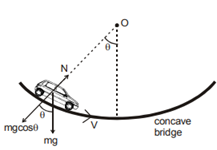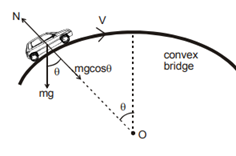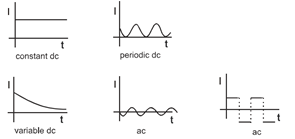Uniform Circular Motion FormulaThe formula for uniform circular motion are as stated below |
||
| Description | Formula | |
| The formula for Angular Distance is | Δθ = ω Δt, Where t is time, ω is angular speed and θ is angular distance. | |
| The formula for linear velocity is given by | v = Rω Where speed and R is radius and ω is angular speed. | |
| The formula for Centripetal Acceleration is given by | Ac = v2/R, Where R is the radius and v is the velocity. Ac = ω2R Where R is the radius and ω is angular speed Ac = 4π2v2R Where R is the radius and ν is the frequency | |
| Average Angular Velocity | \omega_{av}=\frac{\theta_2-\theta_1}{t_2-t_1}=∆θ∆t | |
| Instantaneous angular Velocity | ω=dθ/dt | |
| Average Angular acceleration | \alpha_{av}=\frac{\omega_2-\omega_1}{t_2-t_1}=∆ω∆t | |
| Instantaneous angular acceleration | α=dωdt=ωdωdθ | |
| Relation between speed and angular velocity | v=rω and v=r | |
| Tangential acceleration | a_t=\frac{dV}{dt}=r\frac{d\omega}{dt}=\omega\frac{dr}{dt} | |
| Radial or normal or centripetal acceleration | a_r=\frac{V^2}{r}=\omega^2r | |
| Angular Acceleration | \vec{\alpha}=\frac{d\vec{\omega}}{dt}\ (\ Non-uniform\ motion) | |
| Normal reaction of road on a concave bridge | N=mg\ cos\theta+\frac{mv^2}{r}
 |
|
| Normal reaction on a convex bridge | N=mg\ cos\theta+\frac{mv^2}{r}
 |
|
| Skidding of vehicle on a level road | V_{safe}\le\sqrt{\mu gr} | |
|
\omega_{max}=\sqrt{\frac{\mu g}{r}} | |
| Bending of Cyclist | tan\ \theta=\frac{v^2}{rg}\ | |
| Banking of road without friction | tan\ \theta=\frac{v^2}{rg}\ | |
| Banking of Road with friction | \frac{V^2}{rg}=\frac{\mu+tan\theta}{1-\mu\ tan\ \theta\ } | |
| Maximum also minimum safe speed on a banked frictional road | \frac{V^2}{rg}=\frac{\mu+tan\theta}{1-\mu\ tan\ \theta\ } | |
Alternating Current FormulaThe formula for alternating current are as stated below |
||
|
 A current that changes its direction periodically is called alternating current (AC). If a current maintains its direction constant it is called direct current (DC).
A current that changes its direction periodically is called alternating current (AC). If a current maintains its direction constant it is called direct current (DC). |
|
| Root Mean square Value | Root mean square of a function from is defined as f_{rms}=\sqrt{\frac{\int_{t_i}^{t_2}{f(t)}^2dt}{t_2-t_1}} | |
| Power consumption in AC Circuit | Average power consumed in a cycle
= \frac{1}{T}\int_{0}^{\frac{2\pi}{\omega}}\frac{Pdt}{\frac{2\pi}{\omega}}=\frac{1}{2}V_mI_mcos\phi\ \ \
|
|
| Impedance | z=\frac{V_m}{I_m}=\frac{V_{rms}}{I_{rms}}
 |
|
|
 I=\frac{V_S}{R}=\frac{V_msin\omega t}{R}=I_msin\omega t
I_m=\frac{V_m}{R}
I_{rms}=\frac{V_{rms}}{R}
< p >=V_{rms}I_{rms}cos\phi=\frac{V_{rms}^2}{R}
I=\frac{V_S}{R}=\frac{V_msin\omega t}{R}=I_msin\omega t
I_m=\frac{V_m}{R}
I_{rms}=\frac{V_{rms}}{R}
< p >=V_{rms}I_{rms}cos\phi=\frac{V_{rms}^2}{R} |
|
| Purely Capacitive Circuit |  I=\frac{\frac{V_m}{1}}{\omega c}cos\omega t
=\frac{V_m}{X_c}cos\ \omega t=I_mcos\omega t\
X_c=\frac{1}{\omega C\ } And is called capacitive reactance.
I=\frac{\frac{V_m}{1}}{\omega c}cos\omega t
=\frac{V_m}{X_c}cos\ \omega t=I_mcos\omega t\
X_c=\frac{1}{\omega C\ } And is called capacitive reactance.
 lc Leads by Vc by Π/2 , Diagrammatically it is represented as
lc Leads by Vc by Π/2 , Diagrammatically it is represented as
 Since, \phi={90}^0,
=V_{rms}I_{rms}cos\phi=0
Since, \phi={90}^0,
=V_{rms}I_{rms}cos\phi=0 |
|
Ampere’s Circular LawThe formula for Ampere’s circuital law are as stated below |
|
| Description | Formula |
| Ampere’s circuital law | \int_{\ }^{\ }B.dl=μ°I Here μ°= permeability of free space=4Π×10-15NA-2 B = Magnetic field I = enclosed electric current by the path |
| Ampere’s law (integral form) | \int_{\ }^{\ }B.ds=μ°Ienclosed Ienclosed= enclosed current by the surface |
| Field of a current-carrying wire: | B=μ°/I2πr |
| Field of a solenoid | BL=°NI Here N: number of turns in the solenoid |
| Field inside a thick wire | \int B.ds=μ°I And B=μ°I.r2/πR2 |
| Field of the toroid | B=μ°NI/2πr |
| Force between two parallel current carrying wires | F_\frac{A}{B}=μ°IAIB2πr IA,IB= Current carrying by wires A and B |
Capacitance formulaThe formula for capacitance are as stated below |
|
| Description | Formula |
| Capacitance of a parallel plate capacitor in terms of charge and potential difference | C=Q/V Here, C is the capacitance of the capacitor, Q is the charge stored and V is the potential difference between the plates. |
| Capacitance of a parallel plate capacitor in terms of surface area and distance between the plates | C=\frac{\varepsilon_0A}{d} Here, is the permittivity of free space and its value is 8.854×10-12m-3 Kg-1 s4 A2 is the surface area of the plates and d is the distance between the plates. |
| Capacitance of a spherical capacitor derivation | To find the formula for capacitance of a spherical capacitor we will use the gauss’s law. Let the charge on the spherical surface be , the radius of smaller sphere be and radius of the bigger sphere be . Using gauss’s law, we can write: \oint_{\ }^{\ }\ \vec{E}\cdot d\vec{A}=\frac{Q}{\varepsilon_0} E\left(4\pi r^2\right)=\frac{Q}{\varepsilon_0} E=\frac{Q}{4\pi\varepsilon_0r^2} V=\frac{Q}{4\pi\varepsilon_0r} |
| The potential difference between the plates | V_{ab}=V_a-V_b=\frac{Q}{4\pi\varepsilon_0}\left(\frac{1}{r_a}-\frac{1}{r_b}\right) =\frac{Q}{4\pi\varepsilon_0}\frac{r_b-r_a}{r_ar_b} Therefore, the capacitance will be: C=\frac{Q}{V_{ab}}=\ 4\pi\varepsilon_0\frac{r_ar_b}{r_b-r_a} |
| Energy stored in capacitor | ● U=1/2 CV2 ● U= Q2/2c ● U= QV/2 Here, U is the energy, C is the capacitance, V is the potential difference and Q is the charge stored. |
| Energy density of capacitor | Energy density=\frac{1}{2}\varepsilon_0\varepsilon_rE^2 In vacuum: Energy density= \frac{1}{2}\varepsilon_0E^2 Here, Eo is the permittivity of free space, is the relative permittivity and E is the electric field. |
| Capacitance per unit length of a cylindrical capacitor | Capacitance per unit length= 2ΠEo/In(b/a) Here, Eo is the permittivity of free space, b is the radius of outer cylinder and a is the radius of inner cylinder. |
| Electric field intensity | The formula for electric field intensity between the plates is given as: E= σ/Eo=V/d Here, σ is the surface charge density, V is the potential difference and d is the distance between plates. |
| Redistribution of charge when two charged capacitors are connected in parallel | Let us assume a capacitor with capacitance with initial charge and capacitor with capacitance with initial charge . The final charge on capacitor with capacitance will be: Q’1=C1/C1+c2(Q1+Q2) final charge on capacitor with capacitance will be: Q’2=C1/C1+c2(Q1+Q2) |
| Equivalent capacitance when capacitors are connected in series | \frac{1}{C_{eq}}=\frac{1}{C_1}+\frac{1}{C_2}+\frac{1}{C_3}+\ldots+\frac{1}{C_n} Here, is the equivalent capacitance and are the capacitance of the capacitors. |
| Equivalent capacitance of the capacitors connected in parallel | C_{eq}=C_1+C_2+C_3+\ldots C_n |
| Charging of capacitor | q=q_0\left(1-e^{-\frac{t}{\tau}}\right) Here, q is the charge on the capacitor at time t, is the time constant and is the charge on the capacitor at steady state. |
| Discharging of capacitor | q=q_0e^{-\frac{t}{\tau}} Here, q is the charge on the capacitor at time t, is the time constant and is the charge on the capacitor at steady state. |
 Profile
Profile Settings
Settings Refer your friends
Refer your friends Sign out
Sign out






